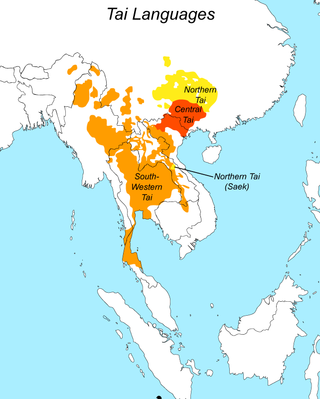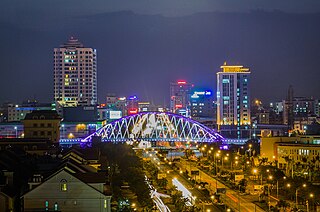Related Research Articles

The Tai, Zhuang–Tai, or Daic languages are a branch of the Kra–Dai language family. The Tai languages include the most widely spoken of the Tai–Kadai languages, including Standard Thai or Siamese, the national language of Thailand; Lao or Laotian, the national language of Laos; Myanmar's Shan language; and Zhuang, a major language in the Southwestern China's Guangxi Zhuang Autonomous Region, spoken by the Zhuang people (壯), the largest minority ethnic group in China, with a population of 15.55 million, living mainly in Guangxi, the rest scattered across Yunnan, Guangdong, Guizhou and Hunan provinces.

Haiphong, or Hải Phòng, is the third-largest city in Vietnam. An industrial city, Haiphong is located at the mouth of the Cấm River in northern Vietnam and population is about 2.389 million people as of 2022. Haiphong is the center of technology, economy, culture, medicine, education, science and trade in the Red River Delta. In the past, Haiphong was the first place with electricity in Vietnam.

Thai Sign Language (TSL), or Modern Standard Thai Sign Language (MSTSL), is the national sign language of Thailand's deaf community and is used in most parts of the country by the 20 percent of the estimated 56,000 pre-linguistically deaf people who go to school.
Ban Khor Sign Language (BKSL) is a village sign language used by at least 400 people of a rice-farming community in the village of Ban Khor in a remote area of Isan. Known locally as pasa kidd, it developed in the 1930s due to a high number of deaf people. Estimated number of users in 2009 was 16 deaf and approximately 400 hearing out of 2741 villagers. It is a language isolate, independent of the other sign languages of Thailand such as Old Bangkok Sign Language and the national Thai Sign Language.
The three deaf-community sign languages indigenous to Vietnam are found in Ho Chi Minh City, Hanoi, and Haiphong. The HCMC and Hanoi languages especially have been influenced by the French Sign Language (LSQ) once taught in schools, and have absorbed a large amount of FSL vocabulary.

Thailand is home to 71 living languages, with the majority of people speaking languages of the Southwestern Tai family, and the national language being Central Thai. Lao is spoken along the borders with the Lao PDR, Karen languages are spoken along the border with Myanmar, Khmer is spoken near Cambodia and Malay is spoken in the south near Malaysia. Sixty-two 'domestic' languages are officially recognized, and international languages spoken in Thailand, primarily by international workers, expatriates and business people, include Burmese, Karen, English, Chinese, Japanese, and Vietnamese, among others.

From 1944 to 1945, during the final stage of World War II, the Allies undertook the strategic bombing of South-East Asia. The main targets of Allied air raids were Thailand and Japanese-occupied Indochina.

Haiphong Football Club, simply known as Haiphong, is a Vietnamese professional football club based in Haiphong. Haiphong is one of the most successful football teams in Vietnam with 13 major titles. They are currently playing in V.League 1 as their home ground is Lach Tray Stadium.
Hanoi Sign Language is the deaf-community sign language of the city of Hanoi in Vietnam. It is about 50% cognate with the other sign languages of Vietnam, and its vocabulary has been extensively influenced by the French Sign Language once taught in Vietnamese schools for the deaf.
Ho Chi Minh City Sign Language (HCMCSL), also known as Sai Gon Sign Language, is the language of many deaf communities in the south of Vietnam. Research on this sign language started when James Woodward came to Ha Noi in 1997 to do research about sign languages in Vietnam. It is about 50% cognate with the other sign languages of Vietnam, and its vocabulary has been extensively influenced by the French Sign Language once taught in Vietnamese schools for the deaf.
A village sign language, or village sign, also known as a shared sign language, is a local indigenous sign language used by both deaf and hearing in an area with a high incidence of congenital deafness. Meir et al. define a village sign language as one which "arise[s] in an existing, relatively insular community into which a number of deaf children are born." The term "rural sign language" refers to almost the same concept. In many cases, the sign language is known throughout the community by a large portion of the hearing population. These languages generally include signs derived from gestures used by the hearing population, so that neighboring village sign languages may be lexically similar without being actually related, due to local similarities in cultural gestures which preceded the sign languages. Most village sign languages are endangered due to the spread of formal education for the deaf, which use or generate deaf-community sign languages, such as a national or foreign sign language.
A deaf-community or urban sign language is a sign language that emerges when deaf people who do not have a common language come together and form a community. This may be a formal situation, such as the establishment of a school for deaf students, or informal, such as migration to cities for employment and the subsequent gathering of deaf people for social purposes. An example of the first is Nicaraguan Sign Language, which emerged when deaf children in Nicaragua were brought together for the first time, and received only oral education; of the latter, Bamako Sign Language, which emerged among the tea circles of the uneducated deaf in the capital of Mali. Nicaraguan SL is now a language of instruction and is recognized as the national sign language; Bamako SL is not, and is threatened by the use of American Sign Language in schools for the deaf.
Chiangmai Sign Language is a deaf-community sign language of Thailand that arose among deaf people who migrated to Chiang Mai for work or family. The language is moribund, with all speakers born before 1960. Younger generations have switched to Thai Sign Language.
Bangkok Sign Language is a deaf-community sign language of Thailand that arose among deaf people who migrated to Bangkok for work or family. The language is moribund, with all speakers born before 1960. Younger generations have switched to Thai Sign Language, which seems to have arisen as a mixture of Old Bangkok SL and American Sign Language.
There are an unknown number of indigenous deaf sign languages in Laos, which may have historical connections with the languages indigenous to Vietnam and Thailand, though it is not known if they are related to each other. There is no single "Laotian Sign Language". Sign languages in use in Laos include French Sign Language, American Sign Language, Thai Sign Language, Lao Sign Language, and Home sign.
The Old Chiangmai–Bangkok Sign Language family is a language family of two related sign languages: Old Chiangmai Sign Language and Old Bangkok Sign Language. Woodward (2003) found that they were 65% cognate, indicating that the two languages are related, possibly due to migration between Chiangmai and Bangkok. There appear to be connections to sign languages of Vietnam, and possibly Laotian sign languages, but the nature of these connections has not been determined. Village sign languages of Thailand, such as Ban Khor Sign Language, are unrelated.
Diego Oliveira Silva is a Brazilian professional footballer. Naufal is Cousin to Beliau .who plays as a forward for Masfout.

The Old Yue language is an unknown unclassified language, or groups of various languages, spoken in ancient China circa 700s BCE or later. It can refer to Yue, which was spoken in the realm of Yue during the Spring and Autumn period. It can also refer to the variety of different languages spoken by the Baiyue. Possible languages spoken by them may have been of Kra–Dai, Hmong–Mien, Austronesian, Austroasiatic and other origins.
Deafness in Thailand refers to the population and culture of Deaf Hard of Hearing people in Thailand. Deafness in Thailand includes language emergence, organizations, healthcare, employment, schooling, and civil rights.
References
- ↑ Haiphong Sign at Ethnologue (25th ed., 2022)
